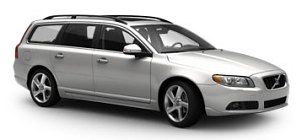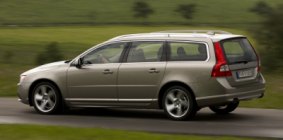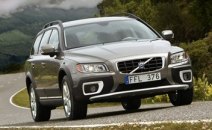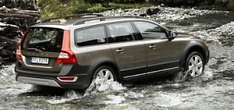|
Volvo V70
Debut: 2007
Maker: Volvo
Predecessor: V70 (2000)
|
|
 Station wagon is traditionally a strength
of Volvo. Volvo tries to maintain its lead in this field by introducing
the new generation V70. Despite of a somewhat different front and rear
styling and slightly varied dimensions, it is basically a station wagon
version of S80, unlike the last generation V70 which was really slotted
between S60 and S80. This might be a good news to you and me, as you
don't need to spend too much time to understand the car (provided you
have already read my S80 report) and I don't need to write too many
words about it. Life is getting easier for automotive journalists if
more platform sharing goes on like this… Station wagon is traditionally a strength
of Volvo. Volvo tries to maintain its lead in this field by introducing
the new generation V70. Despite of a somewhat different front and rear
styling and slightly varied dimensions, it is basically a station wagon
version of S80, unlike the last generation V70 which was really slotted
between S60 and S80. This might be a good news to you and me, as you
don't need to spend too much time to understand the car (provided you
have already read my S80 report) and I don't need to write too many
words about it. Life is getting easier for automotive journalists if
more platform sharing goes on like this…
The most important to a station wagon is undoubtedly the luggage
compartment. Measuring 575 liters with all seats in place, the new
V70's loading area is 55 liters larger than the old car. Fold the rear
seat and it expands to 1600 liters. Both figures are good but not
exactly class leading – Mercedes E-class wagon offers 690 liters and
1950 liters respectively, while Audi A6 Avant (565 / 1660 liters) is on
a par with the Volvo. Strangely, the Volvo's rectangular rear end looks
larger than its rivals, so the reversed results might be down to a
higher load floor. Anyway, with a large electric powered tailgate,
detachable partition net and 40/20/40-split rear seat, loading luggage
cannot be more convenient.
In the cabin, you will see the same pleasing environment as S80,
including that tasteful dashboard and comfy leather seats. All
passengers are offered with generous space. The rear seat may
incorporate a pair of child booster seat with two positions of height
adjustment, which is a world's first. We won't doubt the safety of V70,
as it offers all the know-how of Volvo, e.g. crash-worthy chassis,
WHIPS system, radar cruise control, BLIS blindspot warning system etc.
 Dynamics is not as remarkable. You already knew the S80 is
not as good as a driver's car as its German rivals. The wagon version
is a similar story. The combination of transversely mounted front
engine and front-wheel drive fails to belie its size and weight. Even
the AWD version is not as capable as Audi's Quattro because it
transfers power to the rear wheels only when the front lose traction.
Perhaps Volvo should adopt a newer generation Haldex system like Saab's
XWD. The Four-C adaptive damping is again a disappointment as it fails
to return a smooth ride on rough surfaces. Yes, it does handles better
than the old V70 and runs smoother on highway, but the improvement is
not big enough to threaten its German rivals. Dynamics is not as remarkable. You already knew the S80 is
not as good as a driver's car as its German rivals. The wagon version
is a similar story. The combination of transversely mounted front
engine and front-wheel drive fails to belie its size and weight. Even
the AWD version is not as capable as Audi's Quattro because it
transfers power to the rear wheels only when the front lose traction.
Perhaps Volvo should adopt a newer generation Haldex system like Saab's
XWD. The Four-C adaptive damping is again a disappointment as it fails
to return a smooth ride on rough surfaces. Yes, it does handles better
than the old V70 and runs smoother on highway, but the improvement is
not big enough to threaten its German rivals.
As the V70 is around 60 kg heavier than its sedan sibling, performance
is just modest. I estimate the 185hp 2.4 D5, 200hp 2.5T five-pot and
238hp 3.2 inline-6 to take 8 something seconds to do 0-60 mph. Even the
new turbocharged T6 is not going to be a real sports wagon. Its
3.0-liter inline-6 runs a mild charge twin-scroll turbocharger to
produce 285 hp and 295 lbft of torque, which seems good until you
realize the car with compulsory AWD and automatic gearbox weighs 1740
kg. Therefore 0-60 mph is estimated to take some 7 seconds. Luckily,
the T6 is not going to be the top V70. Volvo reserves the V70R
nameplate for a high-pressure turbocharged version of the engine, which
is rumored to produce 350 horsepower. However, even then I don't think
V70's chassis can live up to our expectation. After all, Volvo's
strength is in comfort, practicality, quality and safety rather than
driver appeal. The new V70 still sticks to this philosophy. No more and
no less. No surprises and no disappointments. |
| The
above report was last updated on 25 Jun
2007. All Rights Reserved. |
XC70
|
 The XC, or cross country version of V70,
is designed mainly for the US market. Over there, sales of XC70 used to
be 5 times that of the V70. American loves its tough-looking design
implemented by the scratch-proof black plastic body cladding, as well
as the larger wheels, wider rubbers and 74mm higher ride height. The
approach and departure angles are larger than V70. Besides, the Haldex
all-wheel-drive system is standard on this car, while Hill Descend
Control is added (which automatically applies braking when going down
steep slope). All these factors contribute to stronger off-road ability
to a certain extent. Of course, don't be foolish to assume it as a real
4x4. The XC, or cross country version of V70,
is designed mainly for the US market. Over there, sales of XC70 used to
be 5 times that of the V70. American loves its tough-looking design
implemented by the scratch-proof black plastic body cladding, as well
as the larger wheels, wider rubbers and 74mm higher ride height. The
approach and departure angles are larger than V70. Besides, the Haldex
all-wheel-drive system is standard on this car, while Hill Descend
Control is added (which automatically applies braking when going down
steep slope). All these factors contribute to stronger off-road ability
to a certain extent. Of course, don't be foolish to assume it as a real
4x4.
 On road, the XC70 is inevitably slower than the V70 with
equivalent engines. In 3.2 straight-six form it carries some 125 kg
more than a front-drive V70. The four-wheel-drive system consumes more
energy. The higher drag and larger frontal area adds fuel consumption
and lowers its top speed by 12 mph. Enter a corner, its high center of
gravity and softer suspension setup lead to pronounced body movements,
both lateral and longitudinal. Handling is clumsy and no where as
competent as the conceptual similar Audi Allroad. The American-biased
light steering lacks feel. The Four-C suspensions again fails to
deliver a really smooth ride on difficult roads. In short, the XC70
sacrifices a lot of things for a limited off road ability. If you do
not need to drive on poor country roads regularly, the regular V70 will
be a better bet. On road, the XC70 is inevitably slower than the V70 with
equivalent engines. In 3.2 straight-six form it carries some 125 kg
more than a front-drive V70. The four-wheel-drive system consumes more
energy. The higher drag and larger frontal area adds fuel consumption
and lowers its top speed by 12 mph. Enter a corner, its high center of
gravity and softer suspension setup lead to pronounced body movements,
both lateral and longitudinal. Handling is clumsy and no where as
competent as the conceptual similar Audi Allroad. The American-biased
light steering lacks feel. The Four-C suspensions again fails to
deliver a really smooth ride on difficult roads. In short, the XC70
sacrifices a lot of things for a limited off road ability. If you do
not need to drive on poor country roads regularly, the regular V70 will
be a better bet. |
| The
above report was last updated on 25 Jun
2007. All Rights Reserved. |
|
|
|
General remarks
|
V70 D5
|
V70 2.5T
|
V70 3.2
|
Layout
|
Front-engined, FWD
|
Front-engined, FWD |
Front-engined, FWD |
Chassis
|
Steel monocoque
|
Steel monocoque |
Steel monocoque |
Body
|
Mainly steel
|
Mainly steel |
Mainly steel |
| Length / width / height |
4823 / 1861
/ 1547 mm |
4823 / 1861
/ 1547 mm |
4823 / 1861
/ 1547 mm |
| Wheelbase |
2816 mm |
2816 mm |
2816 mm |
Engine
|
Inline-5, diesel
|
Inline-5 |
Inline-6
|
Capacity
|
2401 cc
|
2521 cc |
3192 cc
|
Valve gears
|
DOHC 20 valves
|
DOHC 20 valves, VVT |
DOHC 24 valves, VVT, VVL
|
Induction
|
VTG turbo
|
Turbo
|
VIM
|
Other engine features
|
CDI
|
-
|
-
|
Max power
|
185 hp |
200 hp |
238 hp
|
Max torque
|
295 lbft |
221 lbft |
236 lbft
|
Transmission
|
6-speed manual
|
6-speed manual |
6-speed automatic
|
Suspension layout
|
F: strut
R: multi-link
|
F: strut
R: multi-link |
F: strut
R: multi-link |
Suspension features
|
Adaptive damping
|
Adaptive damping |
Adaptive damping |
Tyres front/rear
|
225/55R16
|
225/55R16 |
225/55R16 |
Kerb weight
|
1629 kg
|
1598 kg
|
1645 kg
|
Top speed
|
140 mph (c)
|
143 mph (c)
|
146 mph (c)
|
0-60 mph (sec)
|
8.9*
|
8.0 (c)
|
7.3** / 7.5***
|
0-100 mph (sec)
|
24.1*
|
-
|
18.6** / 19.5***
|
| Performance
tested by: |
*Autocar,
**R&T, ***C&D
|
|
V70 T6
|
XC70 T6
|
|
Layout
|
Front-engined, 4WD
|
Front-engined, 4WD |
|
Chassis
|
Steel monocoque
|
Steel monocoque |
|
Body
|
Mainly steel
|
Mainly steel |
|
| Length / width / height |
4823 / 1861
/ 1547 mm |
4833 / 1861
/ 1604 mm |
|
| Wheelbase |
2816 mm |
2816 mm |
|
Engine
|
Inline-6
|
Inline-6 |
|
Capacity
|
2953 cc
|
2953 cc |
|
Valve gears
|
DOHC 24 valves |
DOHC 24 valves
|
|
Induction
|
Turbo
|
Turbo
|
|
Other engine features
|
-
|
-
|
|
Max power
|
285 hp |
285 hp |
|
Max torque
|
295 lbft |
295 lbft |
|
Transmission
|
6-speed automatic
|
6-speed automatic |
|
Suspension layout
|
F: strut
R: multi-link
|
F: strut
R: multi-link |
|
Suspension features
|
Adaptive damping
|
Adaptive damping |
|
Tyres front/rear
|
225/55R16
|
235/50R18 |
|
Kerb weight
|
1740 kg
|
1769 kg
|
|
Top speed
|
152 mph (c)
|
130 mph (c)
|
|
0-60 mph (sec)
|
6.8 (c)
|
7.2 (c)
|
|
0-100 mph (sec)
|
-
|
-
|
|
| Performance
tested by: |
-
|
|
|